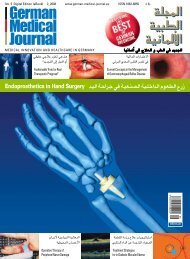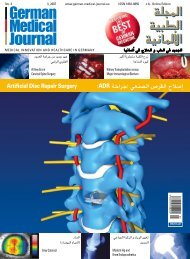Немецкий медицинский журнал Немецкий медицинский журнал
Немецкий медицинский журнал Немецкий медицинский журнал
Немецкий медицинский журнал Немецкий медицинский журнал
You also want an ePaper? Increase the reach of your titles
YUMPU automatically turns print PDFs into web optimized ePapers that Google loves.
Coronary Stents<br />
THE JOURNAL OF MEDICINE FOR THE WORLDWIDE MED COMMUNITY<br />
Коронарные стенты<br />
The most frequently used polymer<br />
in the current generation<br />
of BDS is PLLA and poly-D,Llactide<br />
(PDLLA), both utilized<br />
as resorbable sutures, softtissue<br />
implants, or orthopedic<br />
implant. The PLLA and PDLLA<br />
are metabolized via the Krebs<br />
cycle over a period of approximaterly<br />
12 to 18 months and<br />
converted to carbon-dioxide<br />
and water. At present, no BDS<br />
has either the C.E. mark or<br />
U.S. FDA approval.<br />
The BVS (Bioabsorbable<br />
Vascular Scaffold) EES (Abbott<br />
Vascular) is a manufactured<br />
from PLLA polymer and is<br />
coated with a formulation<br />
of everolimus in a PDLLA<br />
polymer matrix which contains<br />
and controls the release of<br />
everolimus from the stent. The<br />
drug-polymer coating is applied<br />
to the entire stent surface<br />
with a standard concentration<br />
of approximately 8.2μg/mm<br />
stent length and is designed to<br />
release approximately 80% of<br />
the total dose within 30 days<br />
of stent placement; polymeric<br />
strut absorption will take approximately<br />
two years. Following<br />
encouraging pre-clinical<br />
studies, both safety and feasibility<br />
of the first-generation<br />
BVS implant were assessed<br />
in 30 low-risk patients with<br />
de novo coronary lesions who<br />
were enrolled in the propective,<br />
open-label, multicenter<br />
FIM ABSORB study [45]. The<br />
study demonstrated clinical<br />
safety of the BVS as there was<br />
only 1 ischemia-driven MACE<br />
at 6 months, whereas no<br />
MACE events were reported<br />
in the following 30 months. Of<br />
note, no stent thrombosis has<br />
been observed over 3 years<br />
follow-up [46]. At two-year<br />
follow-up angiography, the instent<br />
late loss of 0.48mm and<br />
the diameter stenosis of 27%<br />
did not significantly differ from<br />
the findings at six months. In<br />
addition, there is evidence of<br />
restoration of vasomotor function<br />
in the stented segment<br />
[45].<br />
Beside bioabsorbable polymer-coated<br />
DES there are<br />
bioabsorbable polymer-free<br />
stents. The balloon-expandable<br />
AMS-1 BDS is composed of<br />
93% magnesium and 7% rare<br />
earth metals. The stent has a<br />
high mechanical strenght, and<br />
has properties comparable to<br />
stainless steel stents, such<br />
as low elastic recoil (













